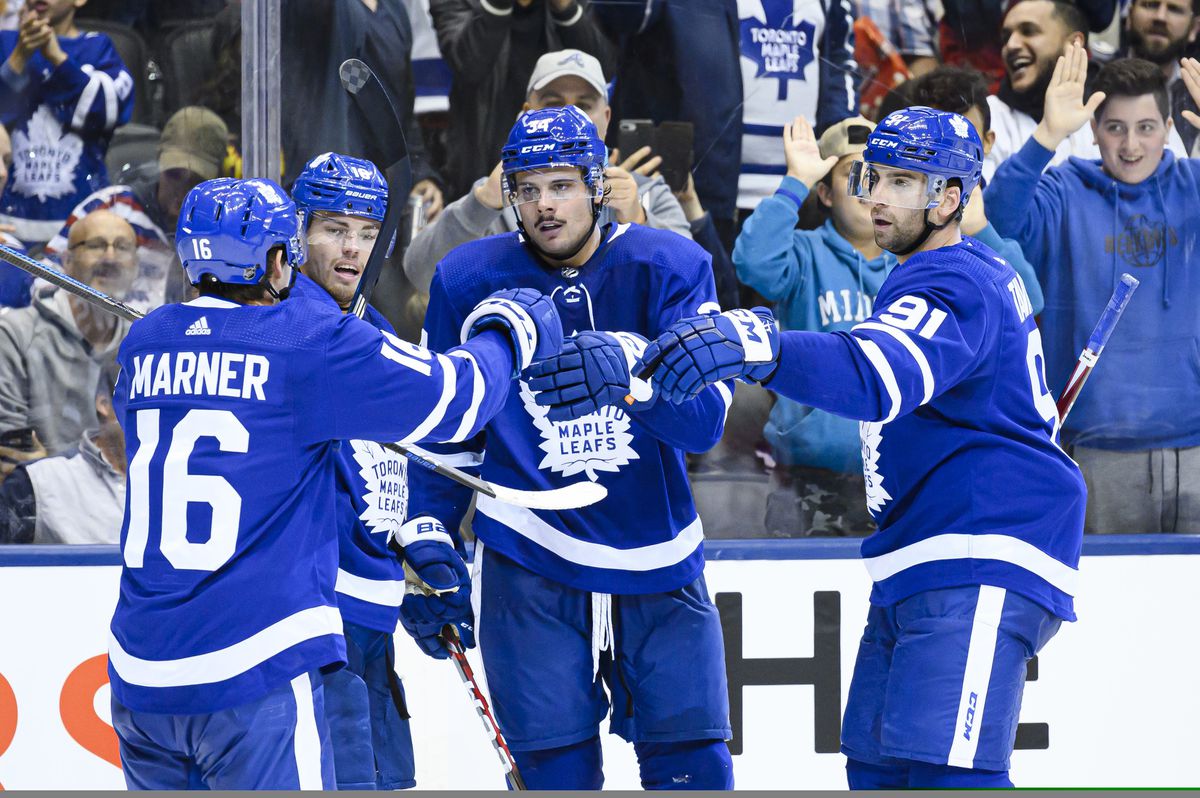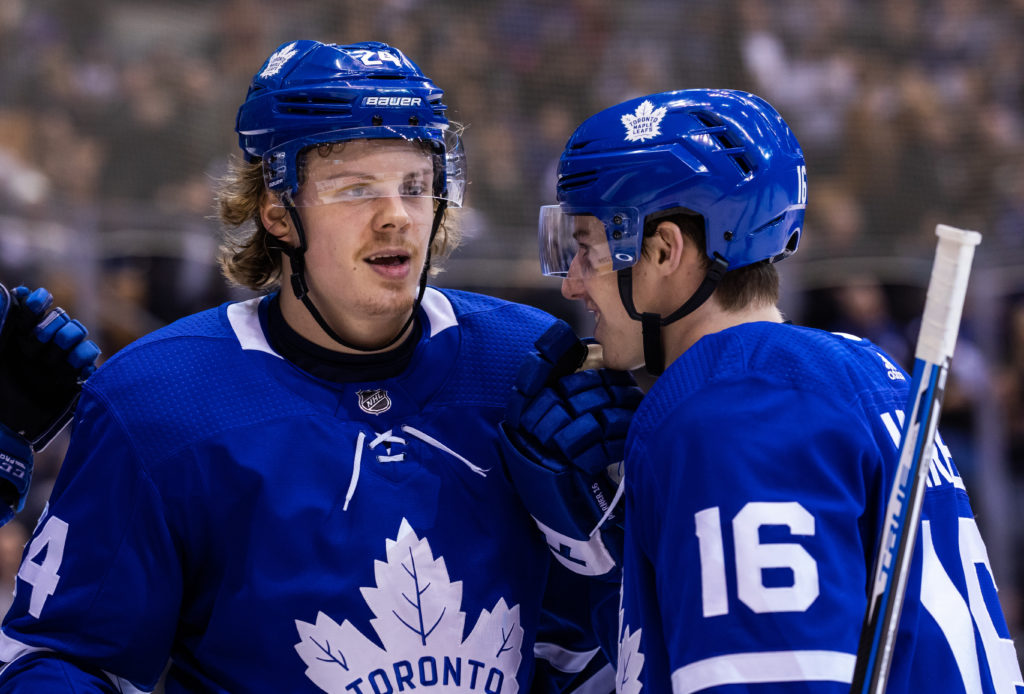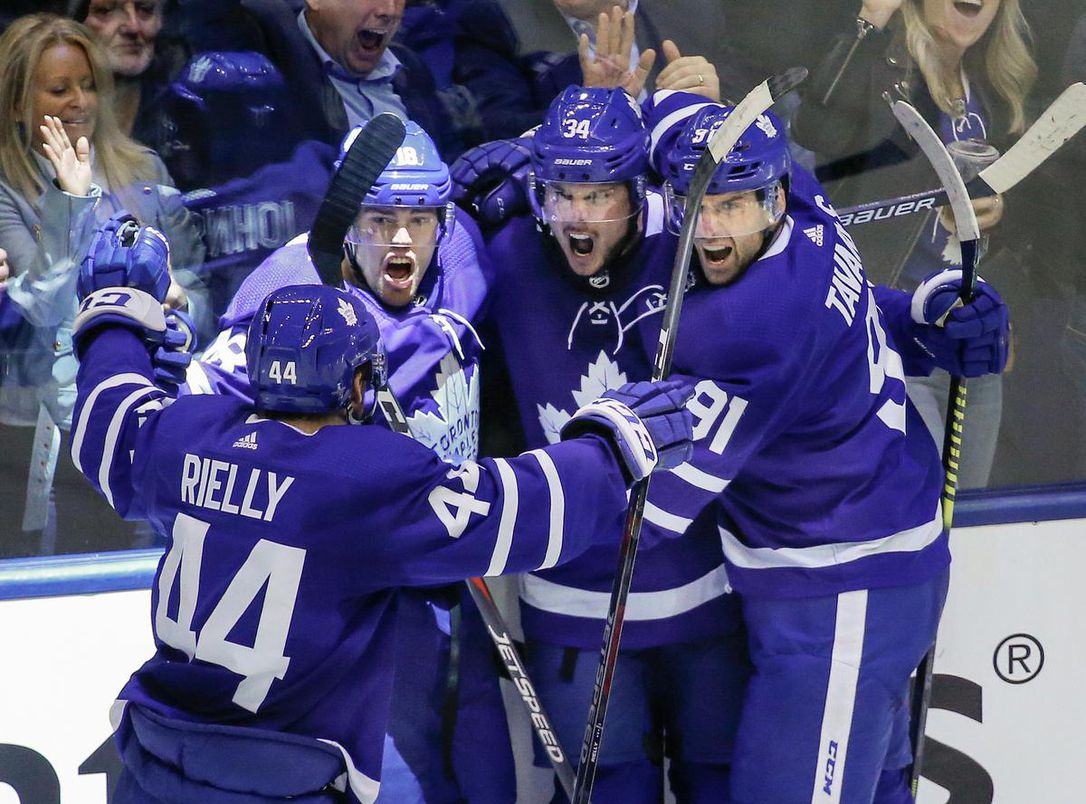In this week’s musings, we’ll focus on the mixed bag of results recently and the work-in-progress Toronto Maple Leafs power play.
We’ll finish up with some thoughts on Kasperi Kapanen’s up-and-down start to the 2019-20 season as well as some scattered notes on the Leafs‘ heaviness, their current roster needs, and the fourth-line deployment.
Panic in Leafs Land

Losses to Columbus and Boston led to plenty of overreactions in Leafs Nation this week. While a strong performance against San Jose quieted down the critics for a short while, Saturday night’s performance against Montreal was like throwing gasoline on the fire.
Now 6-5-2, this Leafs roster was certainly not expected to have more losses than victories nearly a month into the season. While there were plenty of Leafs players to criticize on Saturday night, it’s worth noting that their two biggest problems are currently goaltending and John Tavares’ broken finger.
No one is worried about Frederik Andersen quite yet, but this team will look much stronger once he puts a strong five-game stretch together. Meanwhile, Tavares takes on the toughest matchups while pushing everyone down the depth chart. When this team gets healthy, we are likely to see a top nine consisting of:
| LW | C | RW |
|---|---|---|
| Zach Hyman | John Tavares | Mitch Marner |
| Andreas Johnsson | Auston Matthews | William Nylander |
| Ilya Mikheyev | Alexander Kerfoot | Kasperi Kapanen |
While I’m not in love with the current roster, I have no doubt that the Leafs will have a lethal top-nine when healthy, so it’s difficult to panic all that much. The Tavares-Marner duo was dominant last year, the Matthews-Nylander duo carries a long history of success, and Mikheyev, Kerfoot, and Kapanen are three of the best Leafs of late. They’ll have an overqualified fourth-line winger in Trevor Moore and plenty of options to complement him. There’s not much to worry about up front, and while some degree of criticism is warranted for their play as of late, it’s tough sledding without your best player, especially in back-to-back matchups.
In order to find major criticisms of this roster, we need to focus on the defense. Jake Muzzin continues to be the only defenseman I trust in a shutdown situation right now (despite his blunder to start the third period against the Habs). Morgan Rielly’s point-per-game pace is fantastic to see, but they need more out of him defensively. At his size and strength, he can’t be losing so many physical battles.
The third-pairing is a little bit weak right now, but I’ve liked what I’ve seen out of Justin Holl, while Travis Dermott will add much-needed depth on the back-end. Cody Ceci, who gets criticized by the fanbase for just about everything, continues to look like a bit of an upgrade over Nikita Zaitsev. However, he scares me against opposing top lines and I would like to see his ice time reduced at five-on-five.
Tyson Barrie has been the team’s biggest disappointment to date. He played a weak defensive game against the Canadiens and he’s been held off the scoresheet in ten straight games. Barrie — who finished fifth in power-play ice time last season behind only Alexander Ovechkin, John Carlson, Nathan MacKinnon, and Nikita Kucherov — has gone from 3:55 of power-play time per game last year to just 1:44 this year. Given that he’s not a fit for the penalty kill or a shutdown role, he’s going to have to find a way to create more scoring chances at even strength. First and foremost, the Leafs need him to be average defensively and win more battles.
The million-dollar question with this team continues to be: which defensemen will be asked to shut down the Bergeron and Kucherov lines come playoff time? I’d like to see Muzzin-Dermott or Muzzin-Rielly, but I’m not convinced that Mike Babcock sees things the same way. I heard minor criticism after minor criticism of Babcock this past week, but it’s not playing his starter on the first half of back-to-backs that will make or break his season. He has four particularly talented players in Rielly, Muzzin, Dermott, and Barrie; he needs to ensure that he finds pairings that can work against Boston and Tampa Bay.
Early Thoughts On The New Power Play

Plenty of eyes are on the power play to start the year. Nazem Kadri is gone, there has been a coaching change from Jim Hiller to Paul McFarland, and Matthews and Marner have flipped sides. John Tavares, when healthy, is now in the bumper spot in the middle of the 1-3-1 set-up rather than the net-front presence. Johnsson, who used to play in the middle on the second unit, is now the net-front presence on the top unit. After all of this change, the question becomes: Is the power play any better?
To start, it’s important to note that there are advantages and disadvantages to playing on your one-time side. For certain players, such as Alexander Ovechkin, the choice is a no-brainer. Patrik Laine, Vladimir Tarasenko, Steven Stamkos, Nikita Kucherov, and David Pastrnak are also in this camp, as the one-timer is a huge part of their skillset. The Leafs do not have a big-time one-time threat, so there’s far more room for debate here.
I’m open to giving the current set up a longer look, but at this point, I think I prefer their old set-up. The best that we’ve seen the Leafs power play was at the start of last season. Also, the Marlies‘ man-advantage consistently looks unstoppable with that same set-up. That being said, I still think you can make the one-timer set-up work quite well, but they need to clean up a few things first.
The disadvantage of playing on your one-timer side is that it’s more difficult to carry the puck from high-to-low. Marner receives this puck at the top of the faceoff circle, and unlike Ovechkin, he’s not a dangerous shooting threat from here. If he’s on the opposite side, he can drop his shoulder, drive down low in the zone, and always have the threat of setting up a play while on his forehand. Fumbling the puck costs him half of a second here, and the opposing penalty killer takes advantage by being aggressive.
If I’m coaching a penalty kill that’s up against the Leafs power play, I will live from any shot from distance off the stick of Marner or Rielly. Marner should have sent this back to Rielly to reset and should view a shot as a last-resort scenario.
The above clip is a good example of what Marner can do on the opposite side. He’s able to sell his shot, drive from high-to-low on his forehand, and find Tavares in-front.
Once again, Marner accepts the pass, brings the goalie towards his forehand side, and then slides the puck across to an open teammate. Note that Matthews does not have the one-timer option, but he still makes it work. There’s a tradeoff here, as this set-up can be a little bit more awkward for the left-handed Matthews.
Let’s get back to the current set-up. Marner is able to get the puck lower in the offensive zone and he has more options. The Senators penalty killers completely collapse. Since they do a good job of getting their sticks in the passing lanes, Marner decides to play it safe and dish it back to Rielly.
No one is in within 20 feet of Rielly when he receives this pass, yet he decides to shoot from as far as possible. Although there’s traffic in front, he can certainly take better advantage of this time and space. Regardless of the power play set-up, the Leafs want Johnsson and Tavares to shoot often, Matthews to shoot even more, and Marner and Rielly to be selective.
Kasperi Kapanen’s Rollercoaster Start

After an awfully slow start to the season, Kasperi Kapanen has turned things around in a hurry of late. He looked great in his brief stint with Kerfoot — both players seem to have a knack for creating breakaways. He seems like the perfect player to play lower down in the lineup; even if his linemates aren’t 60-point scorers, he’s still going to find a way to score goals off the rush.
Kapanen is not a great passer and he does not get to the dirty areas like Hyman or Johnsson. His most noticeable offensive skill is his ability to streak down the wing, either scoring via the breakaway or the “Phil Kessel special”. His speed provides him with a fair amount of transition skill and it also helps him defensively. He’s a valuable player with the ability to elevate bottom-six lines, but I think it’s fair to say that he struggled with the Tavares line.
While Hyman is not the best passer either, he’s like a tight-end in football and constantly wins key battles in small spaces. Moore may not be quite as strong as Hyman, but he’s a hard worker in his own right and Mike Babcock has made a point of talking about how he’s able to leverage his body. Both Hyman and Moore looked better than Kapanen in this role, but that doesn’t make Kapanen a bad player.
If Kapanen was a football player, he would not be a tight-end — he’d be a speedy wide-receiver who gives your team a deep threat. The opponent has to respect his speed, opening up more space for his teammates in the neutral zone. Playing on the third line allows him to take advantage of slower third-pairing defenders, while the Leafs can also load him up with ice time on the penalty kill.
Toronto’s most common lines pair a high-end scorer with a high-end playmaker. Both the Tavares-Marner and Matthews-Nylander duos are lethal. “Heavy” players like Johnsson, Hyman, and Moore are able to create chaos by getting to the dirty areas. Both Marner and Nylander benefit from having two forwards who can get to the high-danger scoring areas, as both are skilled enough as playmakers to take full advantage.
I don’t expect any major changes to the Leafs forward group in the near future, so Kapanen will likely have to get used to his role. Fortunately, he looks like an ideal candidate to drive the third line, and that is an important role. The Leafs are a team built around two star centers. If the Kerfoot-Kapanen duo can continue to perform well together, there’s a lot to look forward to in Toronto.
Other Notes

- It sure looks like the Leafs have something in their 2019 second-round pick, Nick Robertson. He currently leads the OHL with 16 goals in just 14 games and he’s going to be a force to be reckoned with at the World Juniors. He was one of the youngest players in his draft class and ranked 24th on my Final Draft Rankings after dominating at the Hlinka-Gretzky tournament. He’s elusive, owns an outstanding shot, and wins plenty of battles for a player of his size. This is not going to be an “empty calories” scorer, so the sky’s the limit for this kid.
- I want the Leafs to play a heavy style. They have plenty of scoring and transition skill, and it’s nice to have players like Jake Muzzin, Zach Hyman, Ilya Mikheyev, Trevor Moore, and Andreas Johnsson to complement their most skilled players. I wasn’t expecting to see Dmytro Timashov in the NHL, but he’s working hard and winning battles, so I’d be willing to give him a longer look. I think teams often get too carried away with playing a heavy style, as they usually don’t have the scoring and transition skill that the Leafs do and typically overpay in free agency. In Toronto’s case, finding just one more shut-down defenseman would go a long way. Up front, they play heavier than they are given credit for.
- Most contenders look to make a key addition before the trade deadline, but the Leafs are going to have to get creative due to their cap situation. I’d be calling the Blue Jackets about David Savard, but I’m not convinced that the Leafs are looking to move Ceci and it may not happen until the offseason. I’d also consider making a huge offer for Hampus Lindholm, but that’s probably a pipe dream.
- The Leafs fourth line was given extreme usage on Saturday night — they received 13 defensive-zone starts and zero offensive-zone starts. By contrast, both the Matthews and Kerfoot lines did not receive a single defensive-zone start. If Babcock plans on continuing this extreme usage, this does not bode well for Timashov’s chances, as I expect that he will want two centers on that line for defensive-zone faceoffs.
- Last but not least, Nick Desouza and I debuted a new podcast last week. The Everything Leafs podcast is currently available on Soundcloud and Spotify and should be on iTunes in the near future. If you are a regular reader of these Leafs Musings articles, or simply prefer podcasts to articles, be sure to check it out!

































